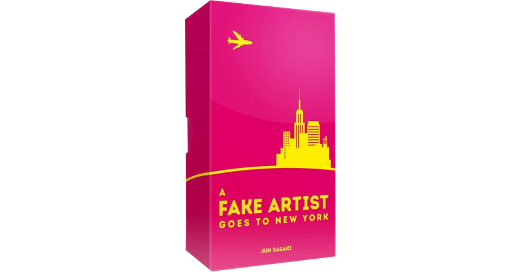Okay, we’re going to talk about bootlegging games.
A Fake Artist Goes To New York is a fantastic game. I do not hesitate to recommend, if you want, to spend the money buying a copy so it can live on your shelf and easily and conveniently bring together all the components you need in your life. I think it’s a great game design and has a great aesthetic and I heartily recommend that you play it ‘properly.’ Buying a copy shows support for the creators and also gets you a nice box which organises everything neatly for you. It’s even quite cheap, considering the price Oink games used to command, and it’s domestically available in Australia too, so you don’t have to wait months for it like you used to, and it’s not being choked by the same international supply problems that are impacting the board game industry in general.

But.
If you didn’t buy it a few weeks ago and you don’t have it, and right now you’re in a family gathering of some variety, or maybe the kids are on holiday and you are crawling the fucking walls trying to find things for them to do, may I recommend this extremely kitbashed version of A Fake Artist Goes To New York?
Okay, here’s the principle components you need, naming only things you already have:
- For each player, you need a coloured pencil, and for them all to be a different colour.
- You’ll need a number of pieces of paper to be ‘the artwork’ – so I recommend your typical printer paper sheets
- You’ll need some scrap paper that can be torn up and distributed to players
Now, in the commercial copy of the game, the gameplay loop works as follows:
- Each round, one player is chosen as the judge. They write down, on slips of paper, the one thing thing that the players are going to try and draw, collaboratively.
- On one of those slips, they draw an X. So those strips should all say the same thing, except one that’s an X.
- Then they distribute those slips, at random to the players.
- These players then, in order, try to draw the thing collaboratively, one line at a time. You can put your pencil down on the page, draw something, then pull it up and that’s it.
- Any time someone thinks they’ve identified the fake artist, they can accuse them.
- If the person they accuse isn’t the fake artist, that player loses, and the fake artist gets a point for the round
- If the person they accuse is the fake artist, the player wins, and they get a point for the round,
- When the drawing is done, there’s a chance to accuse someone, but let’s face it, the points don’t matter.
So the strategy is equal parts trying to communicate that you know the task, but also not give away to the fake information that will make it hard to pick them. But this design, while doable while at home and with a bunch of random craft supplies, does also have a problem in that the judge player has to sit the round out and watch it happen. That may work great for you, that’s cool, but sometimes you only have four people, and having one of them waiting to play can be a bummer.
In that case, here’s an alternative. You do need a set of playing cards, though.
Get a number of cards equal to the number of players and make them match. So, for example, grab the number cards off one suit – one through nine of clubs, for example. Then, take away one card and replace it with the joker. This is now the ‘Fake Deck.’ At the start of each round, shuffle all those cards up, and deal a card to everyone face down. You can check it, and see if you are the Fake for this round.
Next to get the possible subjects, on a bunch of slips of paper, everyone writes ideas at the start of the game of ‘things they want to draw.’ Put them all in a bag, and then rustle them around. At the start of each round, you pull a slip out of the bag, and then every player closes their eyes.
Starting with the player who pulled the slip, that player opens their eyes, and either reads the slip (if they’re an artist) or fakes doing so (if they’re fake) and passes it along. Then they close their eyes again, and knock on the table to indicate for the next player, they need to do the same, and so on.
This way, the drawing assignment is known to all players, but you didn’t need a judge to set it up.
And that’s that! That’s a cheap, bodgy way you can play Fake Artist with your family, at a family gathering, for free, and maybe learn that these kinds of games are fun, without necessarily needing to bust out a box that may scare people off, because they’re weird.